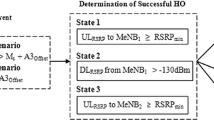Abstract
Data hungry users engage radio resources over long periods of time thus resulting into higher energy consumption by Base Stations (BSs). Mobile operators’ operational expenditure (OPEX) is directly affected by augmented electricity bills due to increased power consumption, thereby ensuing reduced economic and environmental benefits, i.e. profitability of vendors and green communication accordingly. This work provides performance analysis of our proposed reduced early handover (REHO) scheme which results in increased energy efficiency. Impact of reduced energy consumption is shown on OPEX, as well as greener aspects are investigated by inclusion of real life commercial tariffs adopted by one of the mobile operators in the UK. Performance analysis revealed that varying time to trigger (TTT) values significantly impact radio link failure (RLF), ping pong effect as well as call drop ratio (CDR) and Handover ratio (HOR), at changing users’ velocities. Paper investigates and provides a very useful insight for superlative value of TTT for unbiased RLF and Ping Pong, which can help vendors not only to achieve increased energy efficiency, but also maintain other salient performance parameters within acceptable limits. The work also achieves the fact that the time difference in terms of transmission time intervals (TTIs) for reduced early handover in REHO, always remain the same irrespective of the value of TTT, thus ensuring that REHO continuously achieves increased energy efficiency compared to LTE standard.










Similar content being viewed by others
References
Ghosh A, Ratasuk R, Mondal B, Mangalvedhe N, Thomas T (2010) LTE-advanced: next-generation wireless broadband technology [Invited Paper]. IEEE Wirel Commun 17(3):10–22
Mahapatra R, Nijsure Y, Kaddoum G, Ul Hassan N, Yuen C (2016) Energy efficiency tradeoff mechanism towards wireless green communication: a survey. IEEE Commun Surv Tutor 18(1):686–705 First quarter
Ismail M, Zhuang W (2011) Network cooperation for energy saving in green radio communications. IEEE Wirel Commun 18(5):76–81
K. Liu, J. He, J. Ding, Y. Zhu and Z. Liu (2013) Base station power model and application for energy efficient LTE. Communication Technology (ICCT), 2013 15th IEEE International Conference on, Guilin. 86–92.
Katsinis G, Tsiropoulou EE, Papavassiliou S (2016) Joint resource block and power allocation for interference Management in Device to device underlay cellular networks: a game theoretic approach. Springer Mobile Net Appl.
Han C, Armour S (2011) Energy efficient radio resource management strategies for green radio. Commun IET 5(18):2629–2639
Saadat S, Chen D, Jiang T (2016) QoS guaranteed resource allocation scheme for cognitive femtocells in LTE heterogeneous networks with universal frequency reuse. Mob Netw Appl 21(6):930–942
Oh E, Son K, Krishnamachari B (2013) Dynamic base station switching-on/off strategies for green cellular networks. IEEE Trans Wirel Commun 12(5):2126–2136
Mehta M, Akhtar N, Karandikar A (2015) Impact of HandOver parameters on mobility performance in LTE HetNets. 2015 Twenty First National Conference on Communications (NCC), Mumbai, pp 1–6
Muñoz P, Barco R, de la Bandera I (2013) On the Potential of Handover Parameter Optimization for Self-Organizing Networks. IEEE Trans Veh Technol 62(5):1895–1905
Lee Y, Shin B, Lim J, Hong D (2010) Effects of time-to-trigger parameter on handover performance in SON-based LTE systems. 2010 16th Asia-Pacific Conference on Communications (APCC), Auckland, pp 492–496
Andrews JG, Claussen H, Dohler M, Rangan S, Reed MC (2012) Femtocells: past, present, and future. Select Areas Commun IEEE J 30(3):497–508
GA Safdar, K Kanwal (2017) Euclidean geometry axioms assisted target cell boundary approximation for improved energy efficacy in LTE systems. IEEE Syst J (99):1–9
Hanzo L II, Mostafavi SM, Tafazolli R (2008) Connectivity-related properties of mobile nodes obeying the random walk and random waypoint mobility models. Vehicular Technology Conference, 2008. VTC Spring 2008. IEEE, Singapore, pp 133–137
Bettstetter C, Resta G, Santi P (2003) The node distribution of the random waypoint mobility model for wireless ad hoc networks. IEEE Trans Mob Comput 2(3):257–269
3GPP. Evolved Universal Terrestrial Radio Access (E-UTRA) and Evolved Universal Terrestrial Radio Access Networks (E UTRAN): Overall description. TS 36.300, V10.4.0.
3GPP. 3rd Generation Partnership Project; Technical Specification Group Radio Access Networks; Radio Frequency (RF) system scenarios. TR 25.942, V9.0.0
Verbrugge S et al (2006) Methodology and input availability parameters for calculating OpEx and CapEx costs for realistic network scenarios. J Opt Netw 5(6):509–520
Verbrugge S et al. (2005) Modeling operational expenditures for telecom operators. Proc 9th Conf Optic Netw Des Model 455–466
Knoll TM (2014) A combined CAPEX and OPEX cost model for LTE networks. Telecommunications Network Strategy and Planning Symposium (Networks), 2014 16th International, Funchal, pp 1–6
Petrut I, Otesteanu M, Balint C, Budura G (2015) HetNet handover performance analysis based on RSRP vs. RSRQ triggers. 2015 38th International Conference on Telecommunications and Signal Processing (TSP), Prague, pp 232–235
Guo W, O'Farrell T (2012) Capacity-energy-cost tradeoff in small cell networks. Vehicular Technology Conference (VTC Spring), 2012 IEEE 75th, Yokohama, pp 1–5
Saxena N, Sahu BJR, Han YS (2014) Traffic-Aware Energy Optimization in Green LTE Cellular Systems. IEEE Commun Lett 18(1):38–41
Sovacool K (2008) Valuing the greenhouse gas emissions from nuclear power: A critical survey. Elsevier Energy Policy 36:2940–2953
Author information
Authors and Affiliations
Corresponding author
Rights and permissions
About this article
Cite this article
Kanwal, K., Safdar, G.A. Energy Efficiency and Superlative TTT for Equitable RLF and Ping Pong in LTE Networks. Mobile Netw Appl 23, 1682–1692 (2018). https://doi.org/10.1007/s11036-018-1064-5
Published:
Issue Date:
DOI: https://doi.org/10.1007/s11036-018-1064-5




